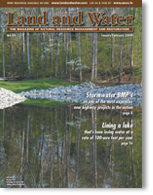Features Available Online
Sand Dune Stabilization at Pineda Ocean Club
by Rande Kessler
Florida’s shoreline erosion challenge has tested the patience and ingenuity of the best coastal engineers for many years. One example of meeting that challenge with innovation was the 2006 Geotextile shoreline subsurface installation at the Pineda Ocean Club in Satellite Beach, Florida. Patterned as a smaller version of the 1989 Caledon Shores, Vero Beach installation (that withstood two back-to-back hurricanes in 2004), the sand-filled geotextile units served as supports for the dune system – thus protecting the upland property while retaining a large amount of the native dune sand in place. After hurricanes Jeanne and Frances, the 1989 Caledon Shores installation had been noted in an FDEP after-storm report as the “lone success story.” Pineda, therefore, was similarly designed to accomplish that same property protection against significant storm erosion.
| Patterned as a smaller version of the 1989 Caledon Shores, Vero Beach installation (that withstood two back-to-back hurricanes in 2004), the sand-filled geotextile units served as supports for the dune system – thus protecting the upland property while retaining a large amount of the native dune sand in place. |
Sand dune core technology consists of large, multi-celled geotextile bags (sand-filled and sand-covered – ProTecTubes TM), which are used to restore and/or secure a primary sand dune or berm. The sloped and stepped design of these bags has demonstrated effective wave-energy dissipation when uncovered and in direct wave interaction. The Pineda Ocean Club property was experiencing significant erosion from storm activity; therefore, geotextile dune core technology was requested. Although the geotextile units would require sand coverage monitoring, Pineda residents realized that with their limited elevation and constant erosion, and the proximity of the Mean High Water line, a significant storm event could completely remove their primary dune and expose the condominium complex to disaster.
Advanced Coastal Technologies’ Subsurface Dune Protection System installed on the Pineda Ocean Club beach consisted of eleven, one-hundred-foot geotextile bags tightly butted against one another in a shore-parallel line. The bags are made of 35-ounce vinyl, covered in a woven shroud of PVC-coated Dacron polyester. The weight of each empty, multi-cell bag before installation is 3200 pounds, and once installed with sand, each weighs several hundred tons. A single unit is 4 cells, approximately 25’ wide, 6’ tall at the landward-most cell, and 100’ long. Each contains approximately 400 cubic yards of sand (that does not have to ever be replaced!).
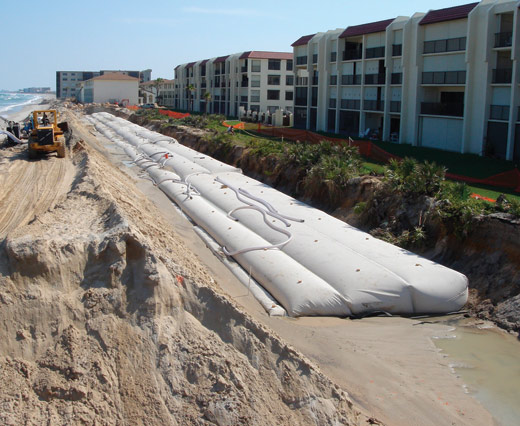
Midway through placement and sand filling the geotextile system.
The Pineda project involved an extensive permit application process. Environmental and installation factors (as well as maintenance concerns) had to be evaluated and approved. Once the Florida Department of Environmental Protection issued the state permit, county and local approvals and beach access permitting followed. There was a natural beach access point just to the north of the project that was identified for equipment and sand shipments, and final details were discussed at the pre-construction meeting held on 24 February 2006. Beach activity began the week of 15 March 2006.
During the permit process prior to February, 2006, a Professional Engineer designed the placement of the dune core units, and once on the beach, a survey team carefully marked the location points. In this particular case, the Pineda Association asked to have the old, failed, sandbag system that was already in place removed as part of the excavation. Those previously installed sandbags were considerably undersized and did not remain intact after storm activity.
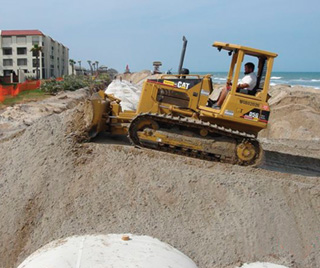
Completed tubes are covered with 3 to 5 feet of sand.
The excavation commenced, with the preparation of a level trench cut into the beach, up against the dune escarpment, to establish the cradle needed for the 1100 feet long and 30 feet wide product placement. The contractor team was experienced and had installed previous dune core projects on the Florida Panhandle in 2005. The excavation moved sand into a coffer-dam, forming a large berm on the seaward edge of the project. This served as a sand source for filling the geotextile bags, as well as temporary protection from regular storm and wave action during the installation process. It also served as the support for the slurry pumping set-up.
A 20-yard open container was brought in and positioned on a 45-degree angle against the newly created sand berm. An hydraulic unit was placed nearby and used with a boom assembly to support a large, jet-type portable sand dredge that operated by being lowered into the “down” end of the sloped container. A sifting grate was attached to the elevated end of the container where the sand was continuously piled and allowed to fall through into the water-filled container. An excavator parked nearby scooped up sand, dropping it on the grate. Under the grate a cross-pattern of PVC piping sprayed water through small holes to keep the sand easily filtering down.
In order to access and provide enough water, a long pipe assembly, called a sea-probe, was moved out into the ocean. That assembly was attached to an intake hose and then to an 8” pump system. The discharge of the pump system was attached to the mini-jets of the sand dredge and to a hose for injecting water into the sloped container. The discharge of the sand dredge was attached to a valved manifold, with three hose discharges available to be attached to various intake ports of the geotextile bags.
After the designed trench depth was reached and the base leveled, each multi-celled geotextile bag was brought in separately on a pallet by a lift vehicle. Each bag was positioned, and unfolded from the pallet as the vehicle backed up, allowing the unfilled bag to be opened into position in the trench, with the toe tube (seaward cell) on the seaward side, and the landward cell against the escarpment. At the end (joint location) of each 100-foot bag, a fabric Junction Mattress (JM) was placed underneath both units with the joint location at the mid-point. The purpose of the JM is to eliminate erosion between installed units, once sand-filled.
Once the first bag was completely unfolded and verified in position, the hose connections from the manifold were attached. The first step was to pump only water into the first unit. The fill sequence was to fill the toe tube first, then to fill each of the next tube cells in order going landward. As this was being done, the other bags were being placed in the flat trench, side-to-side against each other to complete the project length. Bag one was butted up against the seawall return that was part of the southern adjacent property; the final bag was installed with a curved return to eliminate flanking scour.
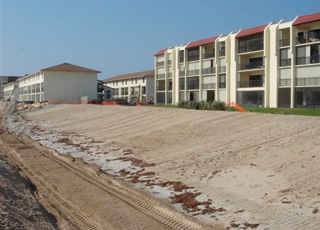
The final dune grade, before vegetation.
After all four cell sections of the ProTecTubeTM unit were water-filled to achieve the profile and all caps were in place, the bag was then sand-filled by using slurry injected into one port of a cell while another port of the same cell, further down, was uncapped. The best sand-water concentration was around 20% to 30% sand, but the key was really just keeping a smooth flow of suspended sand moving. The problem to avoid was an overly-thick mixture that would jam up the fill hoses. Whenever too much sand gathered in the lines, the cure was to force-flow clear water, thereby opening the lines – then to resume with the sand-slurry mix again. One lesson learned on an earlier project was to use clear hoses in the fill process in order to monitor the sand slurry flow. The pressure in the bag was best monitored by watching the plume height of the water exiting the open port “downstream” from the cell’s entry port. A consistent plume height of 6 to 12 inches also meant that the internal seams were not being overstressed while the sand was falling out of suspension and filling the unit.
After several bags were completely sand-filled, the crew began adding sand back on top of the completed sections. Once 18” or more of sand topped the bags, a dozer could then easily drive over it, continuing to push and grade the sand slope to achieve the designed 3:1 slope and overall five-foot sand depth. Ahead of the sand-coverage operation, the crew continued placing and filling bags until all eleven were in place, and all were completely sand-covered.
Since installation, no hurricane has come ashore at the Pineda Club location, so the dune core “firewall” has not been tested to the extreme. Ideally, the technology under the sand will never undergo a real test, but if a significant storm does hit the shoreline, the geotextile, sand-filled dune core project will be there to protect the landward property by drawing a “line in the sand” against further erosion. It is there “just in case,” just like a good insurance policy. The sand coverage is monitored carefully with periodic replenishments to replace loss from minor storm wave action and from strong winds.
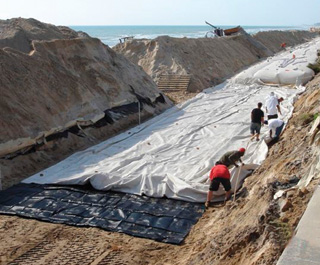
The bags are laid out and joined with junction mattresses.
Even though these geotextile, multi-celled, sand-filled bags have been built and used since the 1980’s and the installation technique refined, an important lesson was learned during the Pineda installation: the need for attention to basics. Two significant delays occurred because of minor adjustments. First, because of the rocky surf-zone subsurface, the sea-probe did not slide easily into the surf as it had in previous sandy bottom installations. And secondly, even though the sand used was approved beach-quality, it contained too much debris, and significant sifting action, therefore, needed. This slowed the slurry-mixing operation. Installers learned to anticipate these two hazards in future installations. Since all dune core projects must be installed between November and April (due to turtle season), speed and efficiency are paramount to the operation. Minor delays can cause major problems.
| Even though these geotextile, multi-celled, sand-filled bags have been built and used since the 1980’s and the installation technique refined, an important lesson was learned during the Pineda installation: the need for attention to basics. |
The Pineda Ocean Club project was successfully completed at the end of April 2006, although the dune vegetation was not planted until later. Today it remains sand-covered and in place, ready to protect the landward property from significant storm erosion. ![]()
For more information, contact Rande Kessler, CEO, Advanced Coastal Technologies, LLC, 334-333-5854 or RandeK@AdvancedCoastalTechnologies.com.
Advanced Coastal Technologies, LLC, P.O. Box 5566, Dothan, Alabama 36302, (877)439-4228, www.AdvancedCoastalTechnologies.com.

